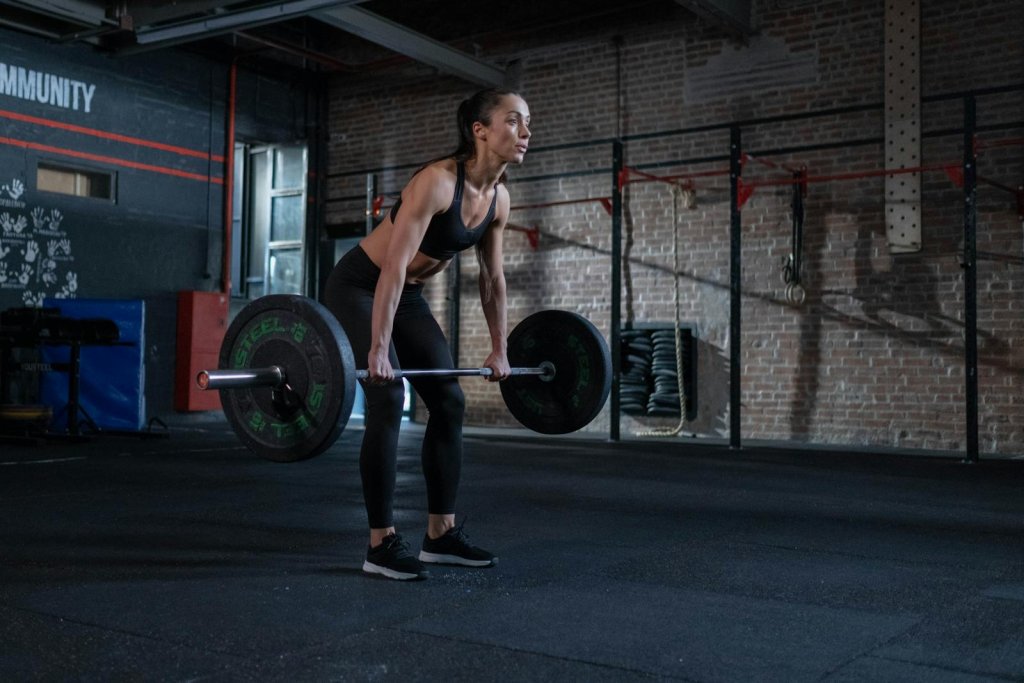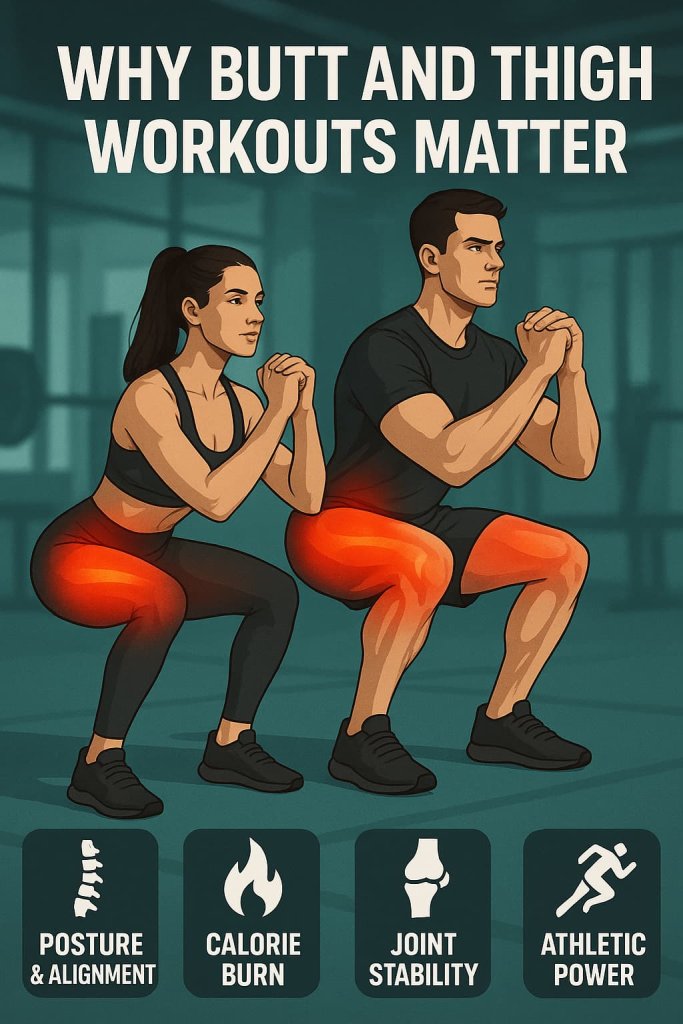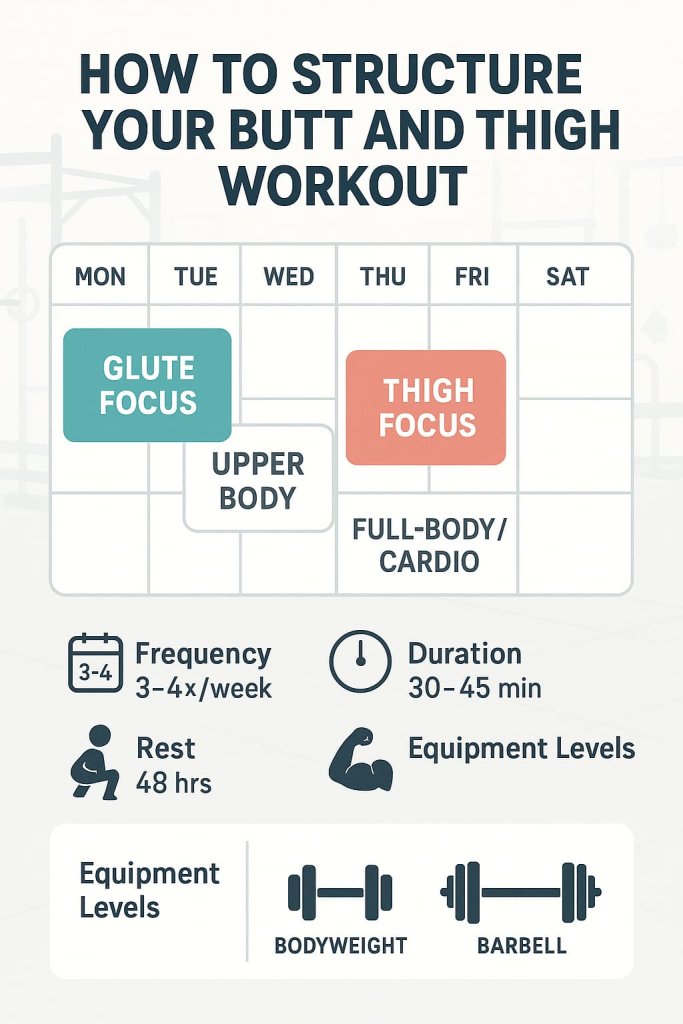The best butt and thigh workouts help you lift, tone, and strengthen your entire lower body — improving balance, power, and definition. Whether your goal is to build round glutes, tighten your thighs, or enhance athletic performance, consistent lower-body training delivers visible and functional results.

Understanding how to train your glutes and thighs correctly is essential because these muscles support posture, core stability, and overall strength. This guide covers 16 of the most effective, science-backed exercises for shaping your butt and thighs — suitable for all fitness levels and goals.
Why Butt and Thigh Workouts Matter
Strong glutes and thighs do far more than improve appearance — they form the foundation for daily movement and athletic power.

According to the Journal of Strength & Conditioning Research (2024), lower-body resistance training improves functional mobility, balance, and joint health while reducing fat mass.
Key Benefits:
- Enhances posture and spinal alignment
- Increases calorie burn through large muscle activation
- Strengthens hips and knees for stability and injury prevention
- Improves performance in running, jumping, and lifting
Fact: The gluteus maximus is the largest muscle in the human body — training it boosts metabolism and total strength.
How to Structure Your Butt and Thigh Workout
To see progress, structure your training with balance, intensity, and consistency.

Frequency: 3–4 sessions per week
Duration: 30–45 minutes per session
Rest: 48 hours between lower-body days
Sample Split:
- Day 1 – Glute Focus
- Day 2 – Upper Body
- Day 3 – Thigh Focus
- Day 4 – Full-Body or Cardio
Equipment Options:
- Bodyweight (great for beginners)
- Dumbbells or resistance bands (moderate intensity)
- Barbell or machines (advanced progression)
16 Best Butt and Thigh Workouts
Below are 16 of the most effective exercises to lift, tone, and strengthen your lower body. Each move targets your glutes, quads, and hamstrings to build power, stability, and definition.
Whether you train at home or the gym, these workouts deliver real results for every fitness level.
1. Barbell Back Squat
Why it works:
The foundation of all lower-body training, this move builds full-leg strength and muscle mass by targeting multiple muscle groups simultaneously. The squat recruits both fast- and slow-twitch fibers, improving athletic power, stability, and metabolism.
Muscles worked:
Glutes, quadriceps, hamstrings, lower back, and core.
How to do it:
- Stand with feet shoulder-width apart, barbell resting across your upper traps.
- Keep your chest tall and engage your core.
- Lower your hips back and down until thighs are parallel to the floor.
- Push through your heels to stand tall and squeeze your glutes at the top.
Trainer Tip:
Drive your knees outward, not inward, during the descent to protect the joints and maintain proper alignment.
2. Dumbbell Bulgarian Split Squat
Why it works:
By elevating one leg, this exercise maximizes glute activation while improving balance and coordination. It’s excellent for correcting muscle imbalances and developing single-leg strength.
Muscles worked:
Glutes, quads, hamstrings, and stabilizers.
How to do it:
- Stand about two feet in front of a bench, holding dumbbells at your sides.
- Place your back foot on the bench top.
- Lower your hips straight down until your front thigh is parallel to the floor.
- Push through the front heel to return to standing.
Trainer Tip:
Keep your torso upright and avoid leaning forward — this keeps the focus on your glutes, not your lower back.
3. Hip Thrust
Why it works:
One of the most effective moves for glute hypertrophy, this exercise directly targets the gluteus maximus through a full range of motion. It also enhances hip power for running and jumping.
Muscles worked:
Glutes, hamstrings, and core.
How to do it:
- Sit with your upper back on a bench and roll a barbell across your hips.
- Bend your knees at 90 degrees, feet flat on the floor.
- Drive through your heels, lifting your hips until your torso forms a straight line from shoulders to knees.
- Lower slowly to the start position.
Trainer Tip:
Keep your chin tucked and squeeze your glutes at the top for two seconds — that’s where the magic happens.
4. Walking Lunges
Why it works:
A dynamic compound movement that challenges stability, balance, and unilateral strength while sculpting thighs and glutes.
Muscles worked:
Glutes, hamstrings, quadriceps, and calves.
How to do it:
- Step forward into a lunge position, lowering until both knees form 90-degree angles.
- Push through the front heel to step into the next lunge.
- Continue alternating legs across the floor or space.
Trainer Tip:
Take long strides to emphasize the glutes; shorter strides shift focus to the quads.
5. Step-Ups
Why it works:
A functional, real-world strength builder that enhances athletic performance and coordination. It mimics climbing or running mechanics.
Muscles worked:
Glutes, quads, hamstrings, and calves.
How to do it:
- Stand in front of a sturdy bench or box.
- Step one foot onto the surface, driving through your heel to lift your body up.
- Step down slowly and alternate legs.
Trainer Tip:
Avoid pushing off with the trailing leg — all force should come from the leading leg for maximum muscle engagement.
6. Sumo Squat
Why it works:
The wide stance engages the inner thighs (adductors) while still challenging glutes and quads, improving flexibility and shaping the lower body.
Muscles worked:
Adductors, glutes, quadriceps, and hamstrings.
How to do it:
- Stand with feet wider than shoulder-width and toes turned slightly out.
- Hold a dumbbell or kettlebell between your legs.
- Lower hips down and back, keeping chest lifted.
- Push through heels to return to standing.
Trainer Tip:
Engage your core and keep knees aligned with toes throughout the movement.
7. Glute Kickbacks
Why it works:
Isolates the glute muscles, helping build shape and firmness while improving hip control and strength.
Muscles worked:
Gluteus maximus, gluteus medius.
How to do it:
- Get on all fours, hands under shoulders and knees under hips.
- Extend one leg straight back and slightly upward.
- Squeeze glutes at the top, then return slowly.
- Repeat and switch sides.
Trainer Tip:
Don’t over-arch your back — keep your core tight and spine neutral for effective isolation.
8. Romanian Deadlift
Why it works:
Emphasizes the posterior chain, developing hamstring flexibility and glute power. It’s key for improving hip hinge mechanics and preventing lower-back injuries.
Muscles worked:
Glutes, hamstrings, erector spinae (lower back), and core.
How to do it:
- Hold a barbell or dumbbells in front of your thighs.
- With a slight bend in knees, hinge at the hips to lower weights toward mid-shin.
- Keep your back flat and shoulders pulled back.
- Drive hips forward to stand up.
Trainer Tip:
Think “hips back” — not “reach down.” This maintains a strong hinge form and prevents rounding the spine.
9. Side-Lying Leg Raises
Why it works:
Tones the outer thighs and stabilizes hips, making it a great accessory exercise for glute medius activation.
Muscles worked:
Glute medius, tensor fasciae latae, and outer thighs.
How to do it:
- Lie on one side with legs straight and stacked.
- Lift the top leg to about 45 degrees, then lower slowly.
- Repeat for reps, then switch sides.
Trainer Tip:
Keep your core engaged and move slowly — avoid momentum to keep tension on the glutes.
10. Curtsy Lunges
Why it works:
Targets inner and outer thighs while shaping glutes for a rounded look and improving hip stability.
Muscles worked:
Glutes, quads, adductors, and core.
How to do it:
- Stand tall, step your right leg diagonally behind your left.
- Lower into a lunge until your front thigh is parallel to the floor.
- Push through your front heel to stand back up.
Trainer Tip:
Avoid twisting your torso — keep shoulders square to the front.
11. Cable Kickbacks
Why it works:
Maintains consistent resistance throughout the movement for optimal glute activation and strength.
Muscles worked:
Gluteus maximus, hamstrings.
How to do it:
- Attach an ankle strap to a low cable pulley.
- Stand facing the machine, holding on for support.
- Extend one leg back and up in a smooth, controlled motion.
- Slowly return to start.
Trainer Tip:
Pause briefly at full extension to intensify the glute contraction.
12. Goblet Squat
Why it works:
A beginner-friendly squat variation that promotes proper form, core engagement, and overall lower-body development.
Muscles worked:
Quads, glutes, hamstrings, and abs.
How to do it:
- Hold a dumbbell vertically close to your chest.
- Lower hips until thighs are parallel to the floor.
- Push through heels to return to standing.
Trainer Tip:
Keep your elbows inside your knees at the bottom for correct squat depth.
13. Glute Bridge
Why it works:
A foundational activation drill that strengthens glutes and relieves lower back stress while improving hip mobility.
Muscles worked:
Glutes, hamstrings, lower back, and core.
How to do it:
- Lie on your back, knees bent, feet hip-width apart.
- Press through heels to lift hips toward the ceiling.
- Squeeze glutes at the top and lower back down.
Trainer Tip:
Add a resistance band around your thighs for extra outer-glute activation.
14. Resistance Band Lateral Walks
Why it works:
Activates the smaller stabilizing glute muscles that are often underused, improving hip strength and joint alignment.
Muscles worked:
Glute medius, abductors, hips.
How to do it:
- Place a mini band around your legs just above knees.
- Bend knees slightly into a mini squat.
- Step laterally, maintaining constant band tension.
Trainer Tip:
Avoid letting your knees cave inward — maintain steady outward pressure on the band.
15. Box Jump
Why it works:
Builds lower-body explosiveness, power, and coordination, making it an ideal plyometric finisher.
Muscles worked:
Glutes, quads, hamstrings, and calves.
How to do it:
- Stand with feet hip-width apart facing a plyo box.
- Swing your arms and jump explosively onto the box.
- Land softly with bent knees. Step down carefully.
Trainer Tip:
Focus on soft, controlled landings to protect your knees and ankles.
16. Single-Leg Deadlift
Why it works:
Improves balance, coordination, and functional strength by isolating one side of the body at a time.
Muscles worked:
Glutes, hamstrings, lower back, and core.
How to do it:
- Hold a dumbbell in your right hand, left hand on hip.
- Shift weight to your left leg and hinge forward, extending your right leg behind.
- Lower the dumbbell toward the floor, then return to standing.
Trainer Tip:
Move slowly and keep hips square to the floor — this ensures true single-leg engagement.
How to Combine These Moves into a Complete Routine
To see real results, structure your workouts with balance and recovery. The ACSM (2024) recommends training glutes and thighs 2–3 times per week with at least 48 hours of rest between sessions.
Beginners (2–3 days/week):
Focus on form and control.
- Day 1: Bodyweight Squats, Glute Bridges, Lunges
- Day 2: Rest or light cardio
- Day 3: Step-Ups, Sumo Squats, Glute Kickbacks
Sets/Reps: 2–3 × 12–15
Intermediate (3–4 days/week):
Add weights for strength.
- Day 1: Hip Thrusts, Split Squats, Cable Kickbacks
- Day 2: Goblet Squats, Deadlifts, Step-Ups
- Day 3: Rest
- Day 4: Band Walks, Curtsy Lunges
Sets/Reps: 3–4 × 10–12
Advanced (4–5 days/week):
Train for power and definition.
- Barbell Squats, Romanian Deadlifts, Hip Thrusts, Box Jumps
Sets/Reps: 4 × 8–10
Trainer Tip:
Warm up before every session, increase weight gradually, and always focus on controlled form for best glute and thigh activation.
Common Mistakes to Avoid
- Rushing reps — prioritize controlled motion.
- Not warming up properly — always perform dynamic stretches first.
- Using too much weight before mastering form.
- Skipping glute activation drills (bridges, band walks).
- Ignoring rest and recovery.
FAQ
1. How often should I train my butt and thighs?
3–4 times per week with at least one rest day between sessions.
2. Can I do these workouts at home?
Yes — most can be done with just bodyweight or resistance bands.
3. Will these exercises make my legs bulky?
No — they build lean muscle and improve tone when paired with proper nutrition.
4. How long before I see results?
With consistency and balanced nutrition, noticeable changes often appear in 4–6 weeks.
5. Should I do cardio with this routine?
Yes — add 2–3 cardio sessions per week for fat loss and endurance.
6. Do I need to lift heavy weights?
Progressive overload (gradually increasing resistance) is key — not just lifting heavy.
7. What’s the best warm-up before leg day?
5–10 minutes of dynamic moves like leg swings, glute bridges, and walking lunges.
Conclusion
Training your butt and thighs consistently not only enhances your physique but also improves strength, posture, and performance in daily life. Whether you train at home or the gym, these 16 exercises deliver results when done with proper form and progression.
Start today — lift, tone, and build your strongest lower body yet.
References
- ACSM Position Stand — Progression Models in Resistance Training (2009, Med Sci Sports Exerc.)
Foundational guidelines on training frequency (novice 2–3 days/week; intermediate 3–4; advanced 4–5), loading zones, and progression—used to structure beginner/intermediate/advanced templates.
View on PubMed - Contreras et al., 2015 — Hip Thrust vs. Back Squat EMG
Shows barbell hip thrust elicits greater gluteus maximus and biceps femoris activation vs. back squat using ~10RM loads—justifies including hip thrusts for glute emphasis.
PubMed - Coratella et al., 2022 — EMG in Deadlift Variations
EMG comparison of Romanian/stiff-leg deadlifts highlights posterior-chain (hamstrings, glutes) recruitment—supports using RDLs for hamstring–glute development.
Full text (PMC) - Martín-Fuentes et al., 2020 — EMG in Deadlifts
Further EMG evidence on deadlift patterns; RDLs show high hamstring activity with manageable erector-spinae demand—useful for exercise selection and sequencing.
Full text (PMC) - Singer et al., 2024 — Inter-set Rest & Hypertrophy (Systematic Review + Bayesian Meta-analysis)
Finds a small hypertrophic benefit for rest intervals >60 s—informs rest prescriptions (60–90 s for most sets; longer for heavy lifts).
Full text (PMC)
